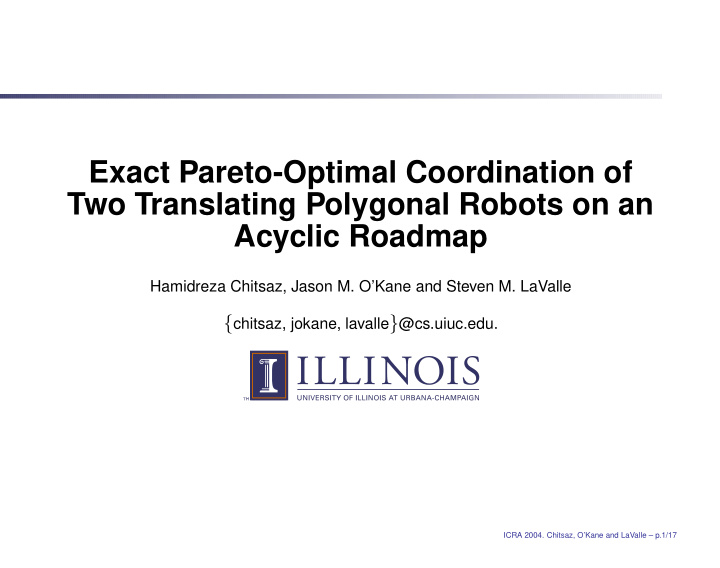



Exact Pareto-Optimal Coordination of Two Translating Polygonal Robots on an Acyclic Roadmap Hamidreza Chitsaz, Jason M. O’Kane and Steven M. LaValle { chitsaz, jokane, lavalle } @cs.uiuc.edu. ICRA 2004. Chitsaz, O’Kane and LaValle – p.1/17
Introduction We want to study coordination strategies for robots in a shared workspace. We allow to individual robots to have separate performance measures. Problem: Find collision-free motion strategies that are optimal in a multi-objective sense. Applications: AGVs in a factory setting. General multiple robot coordination. ICRA 2004. Chitsaz, O’Kane and LaValle – p.2/17
Introduction ICRA 2004. Chitsaz, O’Kane and LaValle – p.3/17
Overview Related Work Problem Statement Robots on Fixed Paths Generalization to Roadmaps Examples ICRA 2004. Chitsaz, O’Kane and LaValle – p.4/17
Related Work Centralized Methods Schwartz and Sharir, 1983 Ardema and Skowronski, 1991 Barraquand and Latombe, 1991 Decentralized (“Fixed Path”) Methods Erdmann and Lozano-Perez, 1986 Akella and Hutchinson, 2002 Siméon, Leroy and Laumond 2002 Peng and Akella, 2003 Roadmap Methods LaValle and Hutchinson, 1998 ICRA 2004. Chitsaz, O’Kane and LaValle – p.5/17
Problem Statement Two polygonal robots R 1 and R 2 translating in the plane. Robots move on roadmaps G 1 and G 2 of piecewise-linear paths. , X goal Initial and goal configurations X init ∈ G i . i i Allow instantaneous changes in speed. Objective: Find a continuous collision-free path C : [0 , 1] → G 1 × G 2 ) to ( X goal , X goal from ( X init , X init ) . 1 2 1 2 ICRA 2004. Chitsaz, O’Kane and LaValle – p.6/17
Optimality For a given coordination, each robot has a cost function: J = ( J 1 , J 2 ) One approach is to choose a scalarization function f : R 2 → R and optimize f ( J ) . Scalarizing may omit interesting solutions. Priorities may change across multiple queries. Better to find a small set of good candidate solutions. ICRA 2004. Chitsaz, O’Kane and LaValle – p.7/17
Pareto Optimality Rather than choosing any particular scalarization, we find the set of Pareto optimal solutions. Create equivalence classes of paths with identical costs. C ∼ C ′ := J ( C ) = J ( C ′ ) Define a partial order on equivalence classes: [ C ] ≤ [ C ′ ] := J 1 ( C ) ≤ J 1 ( C ′ ) ∧ J 2 ( C ) ≤ J 2 ( C ′ ) Pareto optima are the minima in this partial order. ICRA 2004. Chitsaz, O’Kane and LaValle – p.8/17
Coordination Space O’Donnell and Lozano-Perez, 1989 We want to find a path through the coordination space G 1 × G 2 . Obstacle regions where R 1 collides with R 2 . The slope of this curve determines the velocity of each robot. Slope ≥ 1 : R 2 at full speed Slope ≤ 1 : R 1 at full speed. Time to execute a segment is its L ∞ length. ICRA 2004. Chitsaz, O’Kane and LaValle – p.9/17
Optima for Fixed Paths Lemma: Every Pareto-optimal coordination class contains a coordination composed of segments of the visibility graph of the obstacle set, plus possibly a “full speed completion.” Proof Ideas: Given any path, “shorten” it until it’s constrained by obstacle vertices. After moving past the last obstruction, both robots should move at full speed to their goals. ICRA 2004. Chitsaz, O’Kane and LaValle – p.10/17
Optima for Fixed Paths Algorithm: Compute the obstacle set. Find the visibility graph of obstacle set. Add a full-speed completion from each vertex for which this is possible. Use Dijkstra’s algorithm to extract a set of candidate solutions. Candidate = Shortest path to obstacle vertex + full-speed completion. Use direct comparisons to eliminate candidates that are not Pareto optima. ICRA 2004. Chitsaz, O’Kane and LaValle – p.11/17
Fixed Path Example ICRA 2004. Chitsaz, O’Kane and LaValle – p.12/17
Fixed Path Example ICRA 2004. Chitsaz, O’Kane and LaValle – p.12/17
Fixed Path Example ICRA 2004. Chitsaz, O’Kane and LaValle – p.12/17
Fixed Path Example γ 2 γ 1 γ 3 J ( γ 1 ) = (23 , 11) J ( γ 2 ) = (21 , 15) J ( γ 3 ) = (19 , 25) ICRA 2004. Chitsaz, O’Kane and LaValle – p.12/17
Fixed Path Example γ 2 γ 1 γ 3 J ( γ 1 ) = (23 , 11) J ( γ 2 ) = (21 , 15) J ( γ 3 ) = (19 , 25) ICRA 2004. Chitsaz, O’Kane and LaValle – p.12/17
Example ICRA 2004. Chitsaz, O’Kane and LaValle – p.13/17
Acyclic Roadmaps G 1 × G 1 is a collection of 2-dimensional cells pasted together at their boundaries. e × h e h e × f × = e × g f g Same method works. Only need a technique to compute the visibility graph. ICRA 2004. Chitsaz, O’Kane and LaValle – p.14/17
Visibility in G 1 × G 2 Standard algorithm for R 2 (Lee, 1978): Radial sweep about each vertex. Maintain a balanced tree of intersected segments. O ( n 2 log n ) time. Our extension: Radial sweep in G 1 × G 2 . Maintain a separate balanced tree in each for each cell. A ray in G 1 × G 2 passes through at most 2 m cells, where m is the total number of edges. At most 2 m binary tree operations to process each event. O ( mn 2 log n ) time. ICRA 2004. Chitsaz, O’Kane and LaValle – p.15/17
Example ICRA 2004. Chitsaz, O’Kane and LaValle – p.16/17
Conclusion Pareto optimality is an important solution concept for multiple robot coordination. Presented an O ( m 2 n log n ) time algorithm to compute all Pareto optima for problems with m edges in the roadmaps and n obstacle vertices. Future Work: n robots. (with R. Ghrist) Cyclic graphs. ICRA 2004. Chitsaz, O’Kane and LaValle – p.17/17
Recommend
More recommend